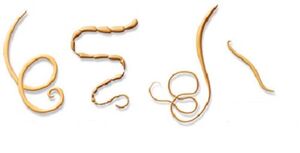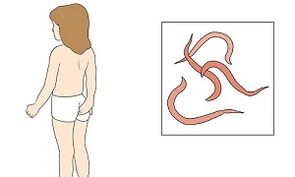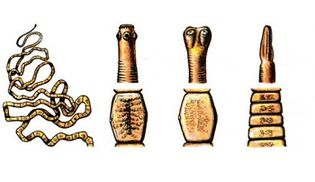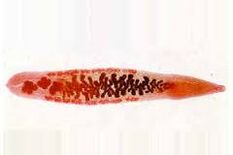Different types of parasites can be in the human body for a very long time, causing very specific damage to health.
A significant number of people suffer from serious diseases caused by parasites. At the same time, many have no idea about the presence of pests in the intestines and other organs.
Every species of parasite known to science has its own individual characteristics that an adult should know about.
Risk of Infection

To date, science has identified more than 200 species of parasites for which the human body is a habitat.
The ways and means of penetration of pests in the most favorable place of residence have been studied in detail. We can say that each type of parasite has its own "specialization".
Many of the helminths live in the gastrointestinal tract. There are also those who parasitize the liver, lungs and even the brain.
Almost all people are subject to parasitic attack. Equally it is just as likely to be an adult or a breastfed baby.
A major risk is the presence of parasites in children. First of all, this is reflected in the state of health. Babies often get sick for no apparent reason.
There is a delay in physical and mental development. It is not so easy to identify the cause of the disease, although it often "stays" in the naked eye.
It is enough to perform certain studies, identify the type of parasite and prescribe a course of treatment.
A considerable number of adults are at risk, as their professional activity is related to the processing of raw materials contaminated with helminths.
Some species of parasites are very resistant to environmental influences and can be destroyed with great difficulty.
Pest varieties
The appearance of parasites in the human body is always accompanied by certain signs.

The following types of helminths parasitize the body:
- round;
- ribbon;
- error.
This classification is compiled taking into account external features, while, regardless of species, parasites have many features in common.
Suction hooks and cups of various shapes have been created to make it easier for parasites to adjust their position in a specific location.
The life cycle of many parasites consists of several stages. Moreover, a species like tapeworm has two "owners" - a male and a pet.
Closed loop migration provides these pests with the ability to exist and reproduce. In the process of movement, the parasite enters the human body and feeds on it.
This feature is natural for all microorganisms that live in the gut or other organs. Only beneficial species are involved in creative activity and parasites are involved in destructive activity.
Given these circumstances, people need to support the useful and suppress the harmful.
Round worms
Ascaris is one of the roundworms. It is an orange parasite with no sucker.
The shape of the tail allows it to migrate through various organs and penetrate into smaller openings and folds. This type of parasite is capable of invading the lungs or pancreas.
Eggs laid by roundworms are protected by a strong shell that can withstand the destructive effects of hydrochloric acid on the stomach. Most often, people become infected by eating unwashed vegetables and fruits.
Pinworm enters the human body in the same way. In appearance, it is a slender worm with pale gray stripes, growing up to 10 mm in length. Already in the larval stage, the parasite begins to harm humans.

By becoming a mature specimen, the larva secretes toxic enzymes that irritate the intestinal mucosa.
An adult worm is able to penetrate the deep layers of the small intestine and penetrate it through and through. In situations like this, a serious disease called peritonitis develops.
Another round parasite that parasitizes the colon is the worm.
When swallowed, the following symptoms appear:
- headache and dizziness;
- persistent abdominal pain;
- sleep disorder.
Vlasoglav got its name from its external features - the worm is very thin and reaches a length of 50 mm. The parasite is the causative agent of trichocephaly.
The body never leaves boundaries - the worm can be destroyed, after which the parasite comes out along with the feces.
Tapeworms
The appearance of parasites in humans follows similar scenarios. Pork strips and strips in the form of strips enter the body when eating meat, namely pork and beef contaminated by the Finns.
Apparently, these Finns, or larvae, are white bubbles and resemble millet grains.
As soon as they reach the intestines, the larvae settle and begin to develop into a complete parasite. Development is asymptomatic in most cases.
After about three months, the tapeworm is now capable of multiplying. This type of pest reaches a length of ten meters or more.
The presence of worms in the body causes a serious disease of teniarhinosis. A more serious threat to human health is the tapeworm parasite Echinococcus.

To this parasite, the human body is an intermediate paradise. The main owners are animals - dogs and cats. Humans become infected through contact with their pets through food - through the mouth.
As soon as they reach the intestines, the eggs begin to develop into larvae, which have six hooks for fixing.
As the bloodstream circulates, they are transported to various organs and most often attach to the liver and lungs.
As it grows, the echinococcus begins to destroy surrounding tissues. Sometimes fairly large parasites are mistaken for a tumor.
Alveococcus is another representative of the tapeworm in the human body. After penetrating the intestine, the larvae develop intensively and penetrate the walls of the small intestine and are carried by the bloodstream to various organs and systems.Like the echinococcus, the parasite is fixed in the liver and begins its destructive activity.
Alveococcus takes the form of a multi-chambered vesicle called a larvae. These larvae are able to invade liver tissue and become cancer-like metastases.The blood supply to the liver tissue is interrupted, necrosis begins, which poses a serious risk to human health and even life.
Fluke Worms
The worm list contains a special species of parasite called lightning.
The following species are particularly endangered:
- mace;
- fashiola;
- schistosoma.

Liver pathologies are more common among human diseases than other diseases of the organs. Flukes got their name because of their anatomical structure.
In the body of the parasite there are several suction cups, with the help of which the pest is held in a certain place and penetrates deep into the living tissues.
Feline vertebrae are most commonly found in the gallbladder and pancreatic ducts.
Fluke enters the human body along with fish that are not salted or boiled enough.
In people affected by this pest, the temperature rises significantly, an unreasonable cough appears and rashes appear on the body. If you do not take emergency measures, then the person may die.
Fzciola is absorbed into the body by drinking unboiled water. With the cooperation of the patient, it causes chronic jaundice.This fact is explained by the fact that a large number of people began to visit tropical places where this pest is widespread.
Preventive measures
Medical practice shows that parasites take root in the gut much more often than in other organs.
Pests of different species are able to adapt to exist in the liver, lungs, heart, brain and even the eyes - only this list gives a sufficient idea of the risk that parasites pose to human health and life. full.

Different types of parasites can enter the body both individually and in combination, which increases the severity of the lesion.
To prevent pests of any kind in your body, it is enough to follow the basic rules of hygiene and sanitary requirements for food.
Young children should be kept under constant supervision, especially in summer when going on land or at sea.
There is no need to eat raw meat or fish today, including sliced meat. This atavism should be left forever in the past, so as not to expose your body to an unjustified danger.
















































